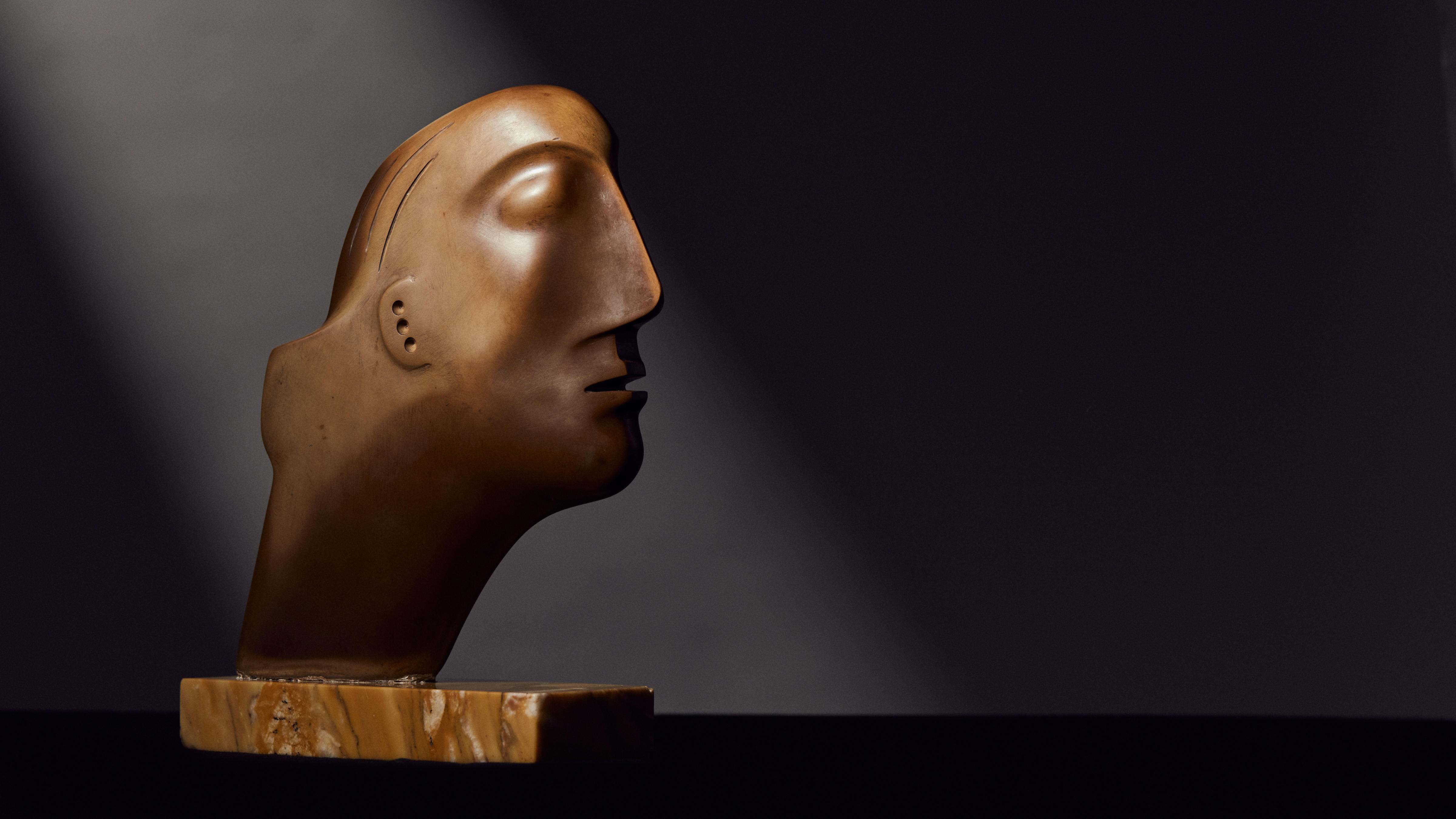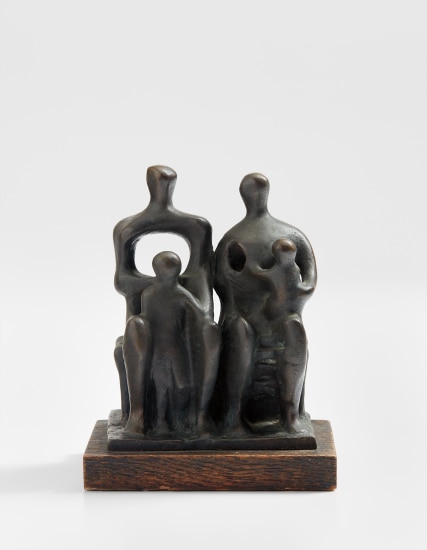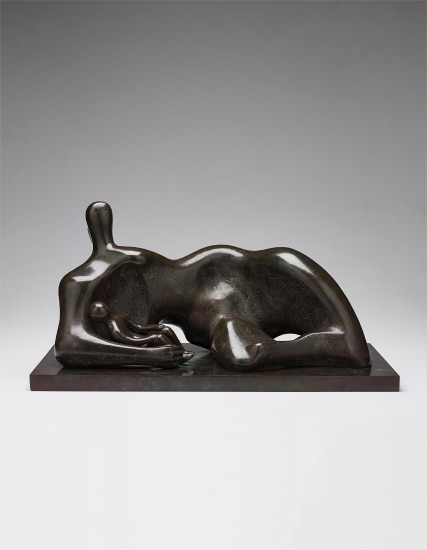101 The Modern Form: Property from the Collection of Betty and Stanley Sheinbaum Henry Moore Follow Three standing figures stamped with the foundry mark 'C. VALSUANI CIRE PERDUE’ on the base bronze with black-brown patina 22.9 x 16.5 x 10.2 cm (9 x 6 1/2 x 4 in.) Executed in 1945, this work is from an edition of 6 plus 1 artist's proof. This work is recorded in the archives of the Henry Moore Foundation.
Provenance Eric Estorick, London Acquired from the above by the family of the present owner in 1960 Exhibited Orange, Chapman College, Henry Moore 31 January - 14 February 1964 (present lot exhibited) Los Angeles County Museum of Art, Henry Moore in Southern California , 2 October - 18 November 1973, no. 21, p. 265 (another example exhibited and illustrated, p. 85) Literature David Sylvester ed., Henry Moore Complete Sculpture, 1921-1948 , London, 1988, vol. 1, no. 258, p. 16 (terracotta version illustrated, p. 164) Henry J. Seldis, Henry Moore in America , Los Angeles, 1973, no. 21, p. 85 (another example illustrated) Catalogue Essay The Universal Form: Henry Moore and Alberto Giacometti in America. Henry Moore’s impact on the post-war American art scene was unprecedented for a British sculptor. The artist’s notoriety in the United States can be traced back to his inclusion in the landmark 1936 exhibition Cubism and Abstract Art, organised by Alfred Barr at the Museum of Modern Art, New York, and his first US show in 1943 at the Buchholz Gallery, New York, whereby Moore’s stateside dealer, Curt Valentin, showed a selection of graphic works by the British artist. The relationship between Valentin and Moore blossomed and the dealer soon became the sculptor’s trusted friend and ally in America. A number of Moore’s most celebrated and monumental sculptures spent time in America before the Second World War, exemplified by his masterpiece, the Hornton stone Recumbent Figure, now housed in the Tate collection, which travelled to the New York World Fair in 1939, not leaving the Museum of Modern Art garden in New York until after the end of the war in 1948. In the same way, Moore’s elm wood Reclining Figure has been held in the collection of the Albright-Knox Art Gallery, Buffalo, since 1939. Despite having a number of his major works in American public and private collections, it was not until Moore’s 1946-1947 retrospective at the Museum of Modern Art, New York, organised by James Johnson Sweeney, where his reputation found a national foothold in America. Appealing to a new humanitarian hopefulness in the wake of the Second World War, Moore’s sculpture encapsulated a sense of progressive and collective humanism; his work promoted man’s relationship to nature through his organic shapes, whilst his celebrated Shelter Drawings encapsulated the tender resolve of the family unit which clung together through the darkness of wartime, to emerge into the light of a world left shattered by the devastating effects of conflict. Moore’s personality and charm combined with his evocation of both classical and primitive art, led to his popularity with actors, critics, curators and collectors alike. In post-war America, newly built and refurbished cities were designed to be functional and utilitarian, and Moore’s outdoor sculptures became increasingly desirable, as did his smaller maquettes and studies. In the same way, Alberto Giacometti’s widespread fame as a leading force of modern sculpture had reached New York by 1948 with his exhibition at Pierre Matisse’s gallery, the catalogue of which included Jean-Paul-Satre’s existentialist essay, ‘The Search for the Absolute’. Purchased between 1959 and 1966, a period of turbulence and civil rights protest in the US, the present works not only demonstrate the exquisite craftsmanship of Moore and Giacometti as modern masters, but also provide enlightened and enriching context as works borne out of a world in international turmoil. As key collectors of progressive and thought-provoking works, Betty and Stanley Sheinbaum’s collection of Moores and Giacometti works is a testament to their devotion to progressive modes of modern representation. Executed in 1945, Moore’s Three standing figures has come to encapsulate one of Moore’s earliest sculptural triumphs, demonstrating his unrivalled mastery of tension, contemplation and profoundness, captured exquisitely in the medium of bronze. Moore formulated his
101 The Modern Form: Property from the Collection of Betty and Stanley Sheinbaum Henry Moore Follow Three standing figures stamped with the foundry mark 'C. VALSUANI CIRE PERDUE’ on the base bronze with black-brown patina 22.9 x 16.5 x 10.2 cm (9 x 6 1/2 x 4 in.) Executed in 1945, this work is from an edition of 6 plus 1 artist's proof. This work is recorded in the archives of the Henry Moore Foundation.
Provenance Eric Estorick, London Acquired from the above by the family of the present owner in 1960 Exhibited Orange, Chapman College, Henry Moore 31 January - 14 February 1964 (present lot exhibited) Los Angeles County Museum of Art, Henry Moore in Southern California , 2 October - 18 November 1973, no. 21, p. 265 (another example exhibited and illustrated, p. 85) Literature David Sylvester ed., Henry Moore Complete Sculpture, 1921-1948 , London, 1988, vol. 1, no. 258, p. 16 (terracotta version illustrated, p. 164) Henry J. Seldis, Henry Moore in America , Los Angeles, 1973, no. 21, p. 85 (another example illustrated) Catalogue Essay The Universal Form: Henry Moore and Alberto Giacometti in America. Henry Moore’s impact on the post-war American art scene was unprecedented for a British sculptor. The artist’s notoriety in the United States can be traced back to his inclusion in the landmark 1936 exhibition Cubism and Abstract Art, organised by Alfred Barr at the Museum of Modern Art, New York, and his first US show in 1943 at the Buchholz Gallery, New York, whereby Moore’s stateside dealer, Curt Valentin, showed a selection of graphic works by the British artist. The relationship between Valentin and Moore blossomed and the dealer soon became the sculptor’s trusted friend and ally in America. A number of Moore’s most celebrated and monumental sculptures spent time in America before the Second World War, exemplified by his masterpiece, the Hornton stone Recumbent Figure, now housed in the Tate collection, which travelled to the New York World Fair in 1939, not leaving the Museum of Modern Art garden in New York until after the end of the war in 1948. In the same way, Moore’s elm wood Reclining Figure has been held in the collection of the Albright-Knox Art Gallery, Buffalo, since 1939. Despite having a number of his major works in American public and private collections, it was not until Moore’s 1946-1947 retrospective at the Museum of Modern Art, New York, organised by James Johnson Sweeney, where his reputation found a national foothold in America. Appealing to a new humanitarian hopefulness in the wake of the Second World War, Moore’s sculpture encapsulated a sense of progressive and collective humanism; his work promoted man’s relationship to nature through his organic shapes, whilst his celebrated Shelter Drawings encapsulated the tender resolve of the family unit which clung together through the darkness of wartime, to emerge into the light of a world left shattered by the devastating effects of conflict. Moore’s personality and charm combined with his evocation of both classical and primitive art, led to his popularity with actors, critics, curators and collectors alike. In post-war America, newly built and refurbished cities were designed to be functional and utilitarian, and Moore’s outdoor sculptures became increasingly desirable, as did his smaller maquettes and studies. In the same way, Alberto Giacometti’s widespread fame as a leading force of modern sculpture had reached New York by 1948 with his exhibition at Pierre Matisse’s gallery, the catalogue of which included Jean-Paul-Satre’s existentialist essay, ‘The Search for the Absolute’. Purchased between 1959 and 1966, a period of turbulence and civil rights protest in the US, the present works not only demonstrate the exquisite craftsmanship of Moore and Giacometti as modern masters, but also provide enlightened and enriching context as works borne out of a world in international turmoil. As key collectors of progressive and thought-provoking works, Betty and Stanley Sheinbaum’s collection of Moores and Giacometti works is a testament to their devotion to progressive modes of modern representation. Executed in 1945, Moore’s Three standing figures has come to encapsulate one of Moore’s earliest sculptural triumphs, demonstrating his unrivalled mastery of tension, contemplation and profoundness, captured exquisitely in the medium of bronze. Moore formulated his
.jpg)


.jpg)


.jpg)
.jpg)







Try LotSearch and its premium features for 7 days - without any costs!
Be notified automatically about new items in upcoming auctions.
Create an alert